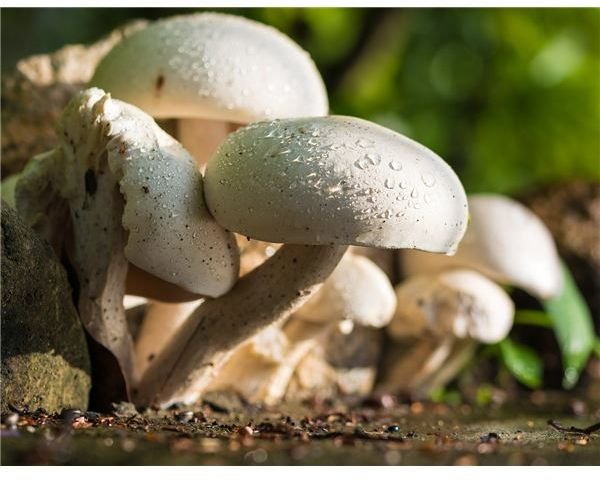Learn About Fungus: Mushrooms, Spores and More
Fungus is among us big time. It’s virtually everywhere, as there are 100,000 known species and there may be a million more waiting to be discovered. The scientists who study them—mycologists—uncover about a hundred discoveries of fungus and varieties every month. And fungi types have been around for about 400 million years.
Neither Plant nor Animal
Funguses are hard to pin down. In the kingdom of life forms, they are neither plants nor animals, even though their appearance may be misleading. Fungi (pronounced FUN-ji) have cells with a membrane around them like plants but they don’t have leaves or flowers and don’t depend on the sun to make their own food. They feed on living or dead matter found around them in a parasitic relationship.
Not an animal, still, fungal cell walls are tough. Called chitin, this type of material is like the outer skeleton of insects.
They are also not like bacteria, which do not have a membrane. And fungus may have one cell, or many cells, being multicellular.
Plants reproduce, but fungi multiply in different ways. So scientists decided to give fungus their own kingdom names. Each fungus has a binomial—or two-part name—that defines its genus and species: like a classification. A button mushroom for example, is Agaricus bi-sporus, a Latin name. Their popular names are much more fun: “witches butter”, “dead man’s fingers” and “jack-o-lantern” and others have been tagged throughout history.
Playing Many Parts
Beautiful parasitic fungus can grow on logs looking like red-ringed scalloped dishes.
They can also:
- Be mushrooms and toadstools,
- Reside in baker’s yeast—often used for bread
- Grow in long thin tubes called hyphae and when massed together are mycelium, a mold whose enzymes can digest old moist bread
- Be found in household dust, decaying veggies and stale food
- Chytrids, a one or unicellular fungus, make a disease called chytridiomycosis that killed 80% of all frogs and toads in a single year
- Fungus yeast also exists in 80% of human intestines where food is processed—but does little harm.
Spores Spreading
If you look at the underside of a mushroom, you will see gills that look very much like fish gills. The gills carry spores, millions of spores, that can travel through the air, by water, rain and even in bird droppings. Stinkhorn fungi, which smell like rotting meat, are a favorite of insects who carry the spores on their legs to new feeding grounds.
Certain wood rot fungi can give off 350,000 spores per second for as long as six months.
Truffles, a delicacy mushroom in restaurants especially in Europe, are found with trained pigs and dogs. These gourmet fungi create a $5-to-10 million dollar industry in supplying gourmet grocery stores.
The Lightest Dough
Saccharomyces or sugar fungus, when mixed with water and a little honey, create yeast. That, when mixed with flour, create enzymes that form a carbon dioxide gas that in turn, generates bubbles expanding the dough and making it rise!
Fungi can also change grape juice into wine, turn grain into beer, morph apples into hard cider and create Japanese sake from rice. These yeast cells have nutritional value containing essential B vitamins, minerals and proteins.
Destroyer Fungi
In addition, a fungus called Phytophthora infestans produced a blight which caused the great potato famine in Ireland in 1845-47 and killed one million people from starvation. Another fungus called Ophiostoma ulmi hitchhiked from Asia to Europe and caused Dutch elm disease in the Netherlands. It was insidious—sinister—and strangled the trees so they could not get water or nourishment. Soon beetles laid their eggs under the bark and when their larvae hatched, it sent sticky spores all across Europe and North America. Grapes crops in France suffered, chestnuts in California were destroyed and avocado trees by the millions died.
Rusts, a species of fungi, can attack wheat, barley, corn, rye and other cereal grains like oats. And smuts, still yet another fungus, affect grasses, wheat and corn generating a smelly, gray, shiny tumor-like growth that ruins crops. Other fungus create poisonous ergots, (Claviceps purpurea), purple in color that hit grasses and cereal grains and can contaminate and infect the whole field.
Farmers now store seeds differently so fungi cannot hide in them and governments inspect food for toxins like aflatoxins that can threaten humans’ health.
Teamwork Fungus
Plants supply fungi with sugars and nutrients in a kind of partnership. The fungi in return help the plants’ roots to absorb water and minerals. The relationship that demonstrates is called mycorrhiza—or, “fungus root.” Amazingly, trees such as sweet chestnuts, apple trees and plants such as strawberries, tomatoes and others, produce better crops with the aid of fungi. Root-dwelling fungi give the plant water and keeps away harmful pests. About 90 percent of plants in nature team up with fungi.
And the Star of the Show…
Penicillin. This is the antibiotic named after the fungus that produced it. It was hailed as a powerful new medicine. It was and still is; only today it is made by chemicals. Even thousands of years ago, Asians treated skin infections with moldy soybeans. The ancient Egyptians use moldy bread on cuts, and people in both China and Japan value shiitake mushrooms to protect against illness.
Tidbits about Fungus
- A popular story about mushroom caps that grow in a ring is that they are “fairy rings” and the elves rest on them between dances.
- In 1992, a giant fungus covering approximately 35 acres (15 hectares) was found underground in a Michigan forest. It pushed up thousands of caps called fruiting bodies.
- Mushrooms can crack cement driveways, move stone slabs and lift basement floors.
References
- Fun Facts about Fungi: Penicillin, the First Miracle Drug
- Souza, D.M. What Is a Fungus? New York: Franklin Watts, 2002. Book
- Henderson State University: Fairy rings
- Wearing, Judy. A Class of Their Own: Fungi. New York: Crabtree Publishing Company. Book.
- Cornell University: Aflatoxins
